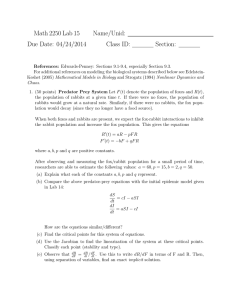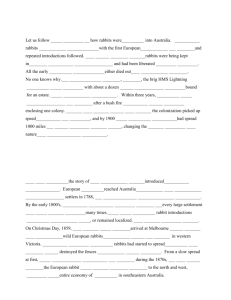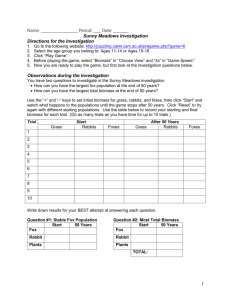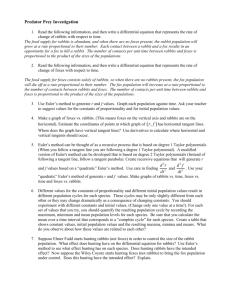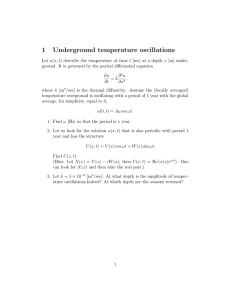Math 2250 Lab 13 Name: Due Date: 04/30/2015
advertisement
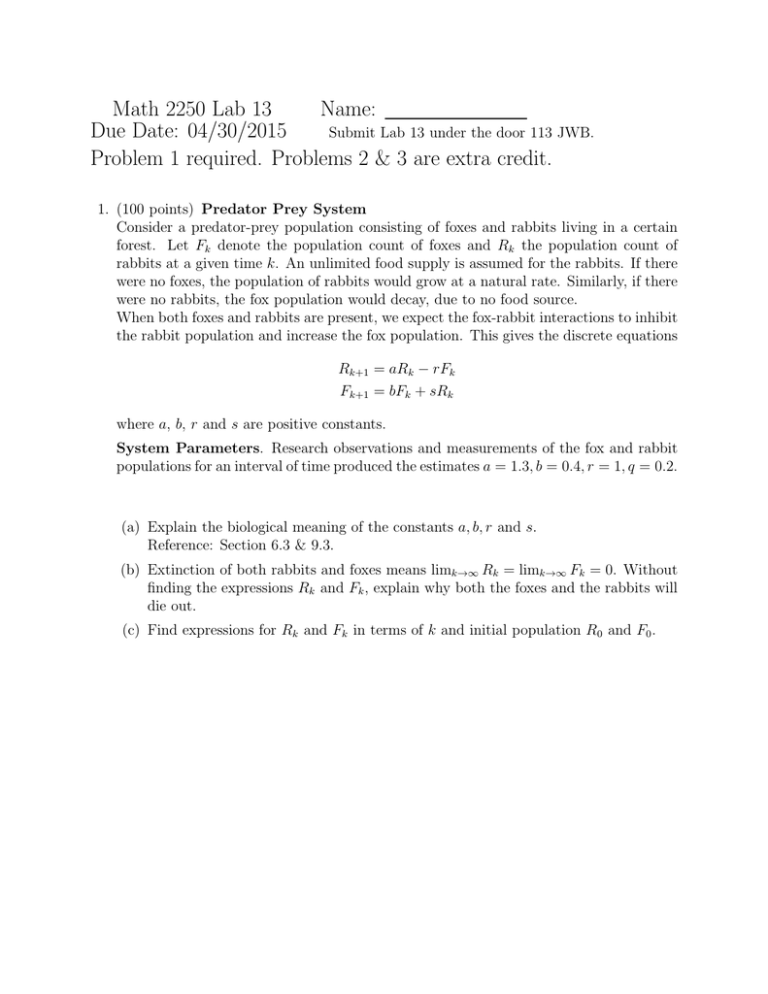
Math 2250 Lab 13 Name: Due Date: 04/30/2015 Submit Lab 13 under the door 113 JWB. Problem 1 required. Problems 2 & 3 are extra credit. 1. (100 points) Predator Prey System Consider a predator-prey population consisting of foxes and rabbits living in a certain forest. Let Fk denote the population count of foxes and Rk the population count of rabbits at a given time k. An unlimited food supply is assumed for the rabbits. If there were no foxes, the population of rabbits would grow at a natural rate. Similarly, if there were no rabbits, the fox population would decay, due to no food source. When both foxes and rabbits are present, we expect the fox-rabbit interactions to inhibit the rabbit population and increase the fox population. This gives the discrete equations Rk+1 = aRk − rFk Fk+1 = bFk + sRk where a, b, r and s are positive constants. System Parameters. Research observations and measurements of the fox and rabbit populations for an interval of time produced the estimates a = 1.3, b = 0.4, r = 1, q = 0.2. (a) Explain the biological meaning of the constants a, b, r and s. Reference: Section 6.3 & 9.3. (b) Extinction of both rabbits and foxes means limk→∞ Rk = limk→∞ Fk = 0. Without finding the expressions Rk and Fk , explain why both the foxes and the rabbits will die out. (c) Find expressions for Rk and Fk in terms of k and initial population R0 and F0 . 2. (Extra Credit 50 points) Cell Dynamics Consider the cell equations dp = k(H − A − p) dt dA = (H − A) dt where variable p represents the response of the cell and variable A describes the internal state of the cell. Symbols k, H, are constants. Symbol H represents an external condition driving the response. (a) Display the nullcline equations. These are the curves obtained from the differential equation by formally setting dp/dt = 0 and dA/dt = 0. (b) Find the equilibria for values H = 1, = 0.1, k = 0.5. (c) Draw the phase portrait, including a direction field. Computer assist expected. Assume H = 1, = 0.1, k = 0.5. (d) The equation for A is the same as Newton’s law of cooling. Show all linear integrating factor or variables separable details used to obtain the solution A(t) = H + (A0 − H)e−t , A0 = A(0) = initial internal state. (e) Substitute the above solution into the equation for p, to create a new first order linear differential equation. Introduce a new variable q(t) = ekt p(t). Please show all details which are used to arrive at dq = k(H − A0 )e(k−)t . dt (f) Solve for q(t) and report the solution for p(t) with arbitrary initial condition p(0) = p0 . (g) Assume H = 1, = 0.1, k = 0.5. Graph the solution (p(t), A(t)) as a phase-plane trajectory for several different initial conditions (p0 , A0 ) (you are to invent values for p0 , A0 ). Are the results consistent with the phase portrait and direction field done earlier? (h) Compute the limit of the solution (p(t), A(t)) at t = ∞. Page 2 Page 3 3. (Extra Credit 50 points) Damped Oscillator as a Dynamical System Consider the following initial value problem for a damped mechanical oscillation: x00 + 4x0 + 5x = 0. x(0) = 2. x0 (0) = −1. We have learned how to solve the above problem in Chapter 5 by considering the characteristic polynomial of x00 + 4x0 + 5x = 0. Investigated here is a dynamical systems solution to the damped oscillation problem (Chapter 7 method). (a) Set v(t) = x0 (t). Show all details for transforming the DE x00 + 4x0 + 5x = 0 into a system of first order equations for variables x and v. The expected answer is 0 x (t) 0 1 x = , v 0 (t) −5 −4 v x(0) 2 = v(0) −1 (b) Solve the dynamical system in part (a) by using the Cayley-Hamilton-Ziebur shortcut method. Reference: Section 7.1, Examples 5, 6, 7. The eigenvalues are complex numbers. The method avoids find eigenvectors and further computations with complex numbers. (c) The computation finds the solution x(t) for the damped oscillator x00 + 4x0 + 5x = 0. Find it another way, using Chapter 5. This is an answer check for all preceding effort. Page 4
